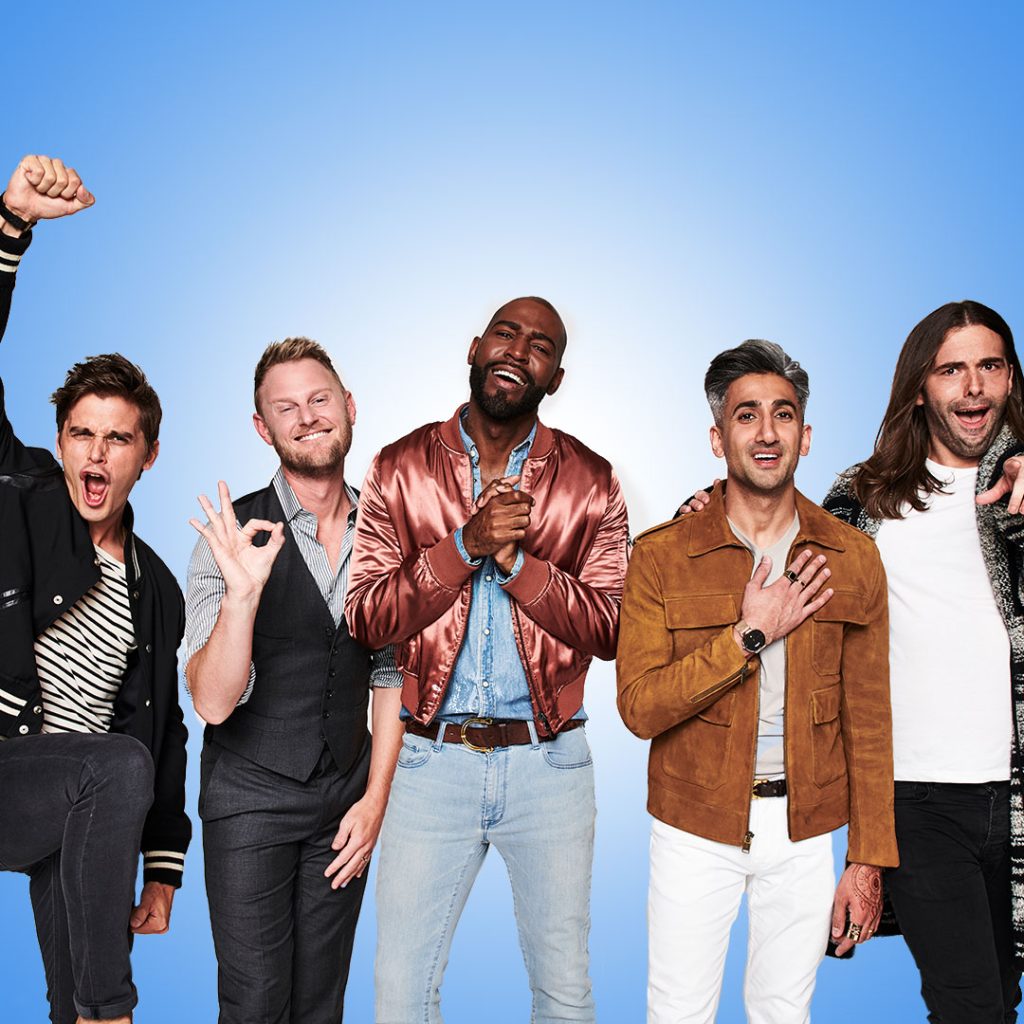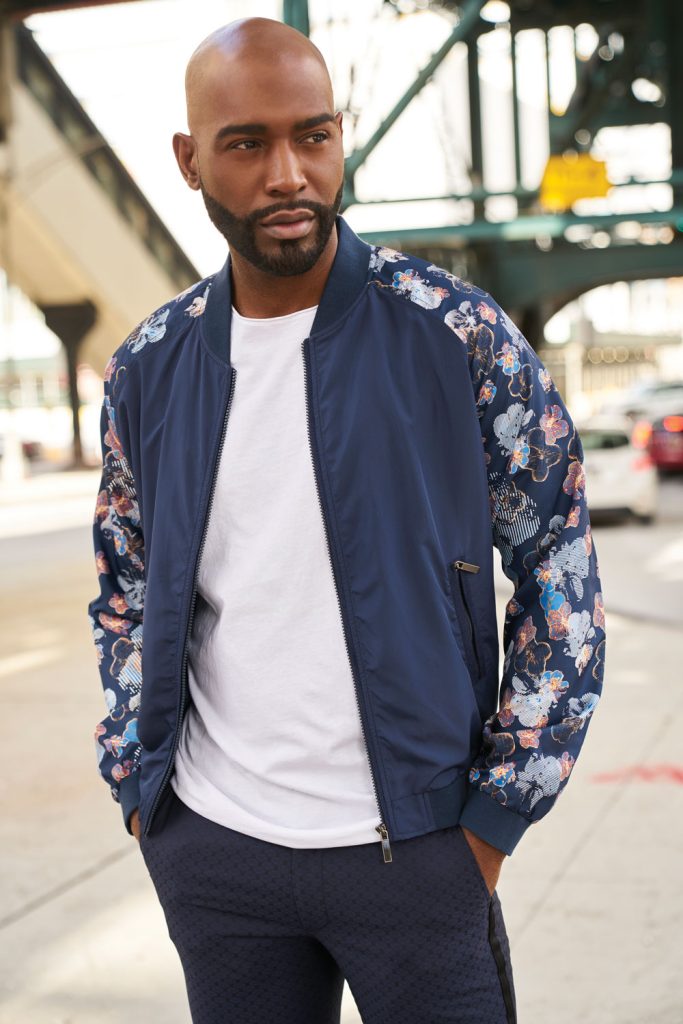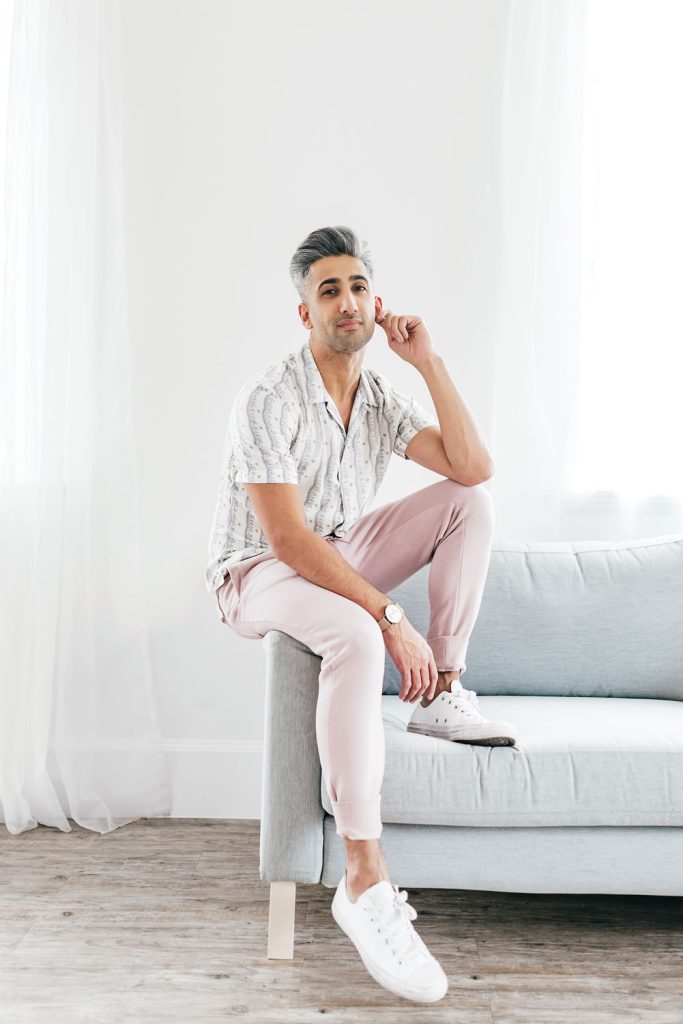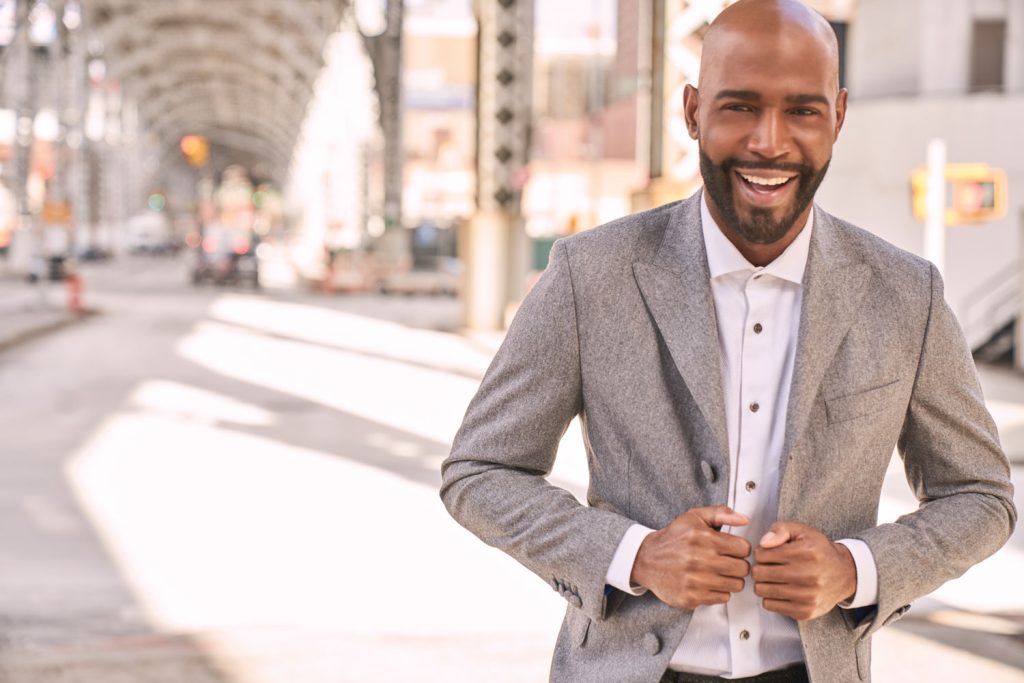REINVENTING, REDEFINING AND MOVING FORWARD
KERAMO BROWN & TAN FRANCE
A CONVERSATION BEYOND COLORS
~ by joel martens ~

karamo brown, tan france and jonathan van ness
Sometimes it seems that no matter how much the world has changed, when you look just below the surface it can often feel like nothing has changed at all. Our current political climate and the rise in anti-gay, anti-woman, anti-immigrant mentality and the widening color divide are perfect examples of what, at first glance, feels like a return to a
darker age and time.
To be sure, we have had some setbacks and they lately continue to come at a frightening pace. But, when you look at the broader picture, taking the longer view, the world has definitely changed a great deal…And, it has done so for the better. It wasn’t that long ago that the closet was the place relegated for most of us in the LGBT community and it wasn’t a nice place to live, at all. Fear was often the mainstay for many: police raids, institutionalization and persecution were the norm and up until the mid-point in this century it was something we had to live with.
Fast forward to 2018. Though we have had a series of setbacks, gay marriage is still the law of the land and we for the most part are free to go about our business in relative safety. In fact, most of us, though certainly not all, are able to take for granted the way of life so hard fought for by our forebearers.
How does this all relate to a television show that focuses five gay men on a male subject and tasking them with remaking their lives on Queer Eye you might ask?
Well, let me tell you what I’m thinking…
For its time, Queer Eye (then For The Straight Guy) was a cultural phenomenon when it debuted in 2003, as the show took on a group of straight men and rearranged their lives, albeit pretty superficially. We certainly didn’t talk about their feelings or delve too deeply into their personal lives, at least past their clothes, eating habits and living rooms. I make this observation with respect however, the show was definitely reflective of its time. But undoubtedly, five gay men as leaders on a popular television series was indeed remarkable.
Context is everything…
Now let’s chat about change and how it’s reflected in the current reboot of Queer Eye, (sans For The Straight Guy, which was dropped to add a more universal appeal). The most recent fab five are decidedly different and they are for several reasons: The most obvious being that they are definitely more colorful than the previous cast…and we mean that quite literally. Karamo Brown and Tan France have taken the show a step forward being persons of color and in turn, reflecting different cultural sensibilities. Something lacking in the first iteration and it’s a long overdue, welcome change.
Unique also, because it has been removed from the New York’s sophisticated streets with all its designer access and relocated to Atlanta and its surrounding area, which for certain changes the vibe of the show…fairly dramatically. The comfort of big city exposure is gone and is replaced by the not-so-liberated sensibilities of the Deep South.
Another notable difference is one not so obvious. The show still takes on men who are in sore need of a remake, but this time, the change goes a little deeper, digging into the reasons for the disarray and the unkemptness of their lives… A sometimes-emotional journey, I’m sure many relate to.

Karamo Brown explained this aspect of the show best, “My background in social work just lent itself to being a listener and providing a service for someone…I literally did it day in and day out. Someone would say, “This is what my backstory is, this is the trauma I’ve had in my life, this is where I hope to be. Can you help me?” It was all about really understanding and meeting them where they lived, so that I could help them to figure out where they are.” He went a step further with, “One of the biggest things I’ve learned is that you can provide someone with permanent housing, you can provide them with food, you can provide them with clothing all day long, but until you change their mindset and their hearts that is never going to stick.”
That’s what I really tried to bring to the show,” Brown continued. “Trying to figure out a way to make it entertaining—fixing their hair, fixing their outfit, fixing their house—that’s all fine. But, if they don’t feel like they’re worthy of it, all they’re going to do is destroy it again. If they’ve never felt beautiful, then the minute you leave they’re just going to revert back to how it all was before.”
Delving a little deeper, Brown talked about the motivators often hidden behind lack of care and how they worked to help their guys maintain the changes. “What makes me feel like I want to go back? What makes me feel like I’m not worthy of this? What makes me feel like people don’t love me?” If you can check in with yourself daily, you’ll be okay.”
Tan France piped in regarding the timing of the show and the difference in content, adding, “The premise of this version of the show is so much more emotionally driven than any of us really expected. We have a platform from where we can have a difficult conversation and we don’t shut up about it and that has been amazing so far,” he said. “The timing was such a smart move on Netflix’s part. They really knew that this was the right moment to make it happen. And the best part…the response has been completely insane so far.”
Brown opined further, “What I love about QE is that we are able to be as open as possible and to be holistic as possible and bring ourselves fully to the conversations we have with these folks that you normally wouldn’t have. In the first iteration of the show they weren’t having conversation like this.” Continuing with, “You wouldn’t hear Carson having a conversation with a cop about police brutality, it just wasn’t happening. You’ve not seen Thom Filicia having a conversation with someone about religion and Christianity. These are the things we’re doing and still having fun.”
We talked further about the differences between QE and the original Queer Eye for the Straight Guy: how important a milestone it was for 2003 and how that bares out in 2018 with the new iteration. “I wasn’t massively aware of the American version,” offered Tan France. “But I was aware that it was one of the first authentic shows with very real gay men on television. I’d seen Will & Grace, but on the whole, they had all been actors playing gay men. They had a script and what they said was something that a team of people had come up with. I had never seen before a moment on television where people were truly themselves, and what they said was what they thought and felt. It spoke to me and what I thought and felt, so for me it was a really important show.”

France talked about how important it was to him to have representation from the community of color for the reboot. “When I had the opportunity to do QE I saw it as more of an opportunity to show a gay man of color on a successful show, which is really important to me,” he offered, “We have a lot of white gay representation on TV and I love it and we do need even more. But, I have never seen a version of me on television, literally never, and that was really important to me. I’ve never seen a Middle Eastern, immigrant man who is gay, represented and especially with my coloring…so I felt like it was really important for me to take this job. If I had something like this as a child, someone who looked like me, talked like me, was any kind of version of me, life would have been easier. I would have been able to understand that it wasn’t a curse that I had on my head, being gay.”
“For me the important thing when I agreed to be a part of it,” continued France, “was that I was able to do for my community—and I’m not just talking for my Middle Eastern community—but for the broader world and not just the U.S. I want to do for them what the original show did for Americans, or maybe the West. The original show really did a lot and I think that sometimes they aren’t given the credit they deserve. Yes, it was a pop culture show, but it was so much more than that because it was a pioneering show. I know that is sort of a grand statement and that there’s a big presumption here, but I do think we can affect change because it is such a massive show with a big audience.”
One of the interesting changes in the new QE is that even though being gay is a big part of what drives the show, it isn’t the only thing doing it. In fact, in many ways it’s kind of an afterthought, or maybe better said, like it is for each of us, it’s just an aspect of the overall show. Karamo Brown talked about the differences, “Most of the time we walk through life and gay is not the first thing we talk about. We have so many other parts of our identities that come up: As husbands, or fathers, or as businessmen, or as religious men or whatever the case may be. Those things come up and not the person I’m sleeping with—unless you’re discussing your husband or partner—most times that’s the last thing I talk about. When I meet someone it’s not like, ‘Hey I’m Karamo and I’m gay.’”
“I think for a while, people in our community felt this need to identify first, instead of showing the complexities of intersectionality and who we are,” Brown continued. “I think that’s why this show is special. Even though it’s called Queer Eye, we’re all proud to be who we are. None of us are hiding that. We also don’t forget like with Bobby, who was very religious and then traumatized by religion. When he met this guy it wasn’t like, hey let’s talk about being gay, it was, ‘I used to be a Christian and ya’ll tortured the shit out of me. So, let’s talk about that because I don’t really care for you at all.’ Same thing with me and the cop—I’m a black man raising two black kids and before I even try to help you—I need to get through that conversation first.”

France added his observation about how powerful the show’s message can be and the affect it could have on those who need it most. “With us being in the South, it’s so much more effective, because we’re meeting people who most likely haven’t met anyone like me, who looked like me, talked like me or had the opinions I had. And that’s the same with Karamo, as well. I’m again not trying to denigrate my boys, they are wonderful, and I love them to pieces, but the world has seen white gay boys on television before. What they haven’t seen was what Karamo and I are about and what we have to say. I think it was a genius move on Netflix’s part to have it shot in the South, because if it was in New York or London, the show would not be what it is.”
“And, we can do it without being overly political at the same time,” he continued. “We’re telling our side of the story, but we’re not pushing forward an agenda. We’re saying, ‘Meet us in the middle and let’s talk about this.’ It’s not a case of your way is wrong and I need you to understand my way is right…That’s not the case at all. It’s more of an ‘I don’t understand your politics, you don’t understand mine…let‘s have a conversation and see if we can find some common ground,’” France offered. “It’s all done on an open platform, we’re playful, we’re very loving so it’s a lot easier to digest than it would be if it was five guys on a political panel show. For me the show means so much more than being famous…It’s not at all about that. Hopefully it means that we get to be a presence or a comfort for a community that is still so massively underrepresented.”
Brown added his views about the timeliness of the show and how necessary the message of acceptance still is. “It was ironic to me when the show was first announced that LGBT people thought there was no need for the show. As if we had just progressed to a place where there was no longer need for images of our community on television and there was no longer a need for a conversation.” He continued, including his ideas about the importance of QE, queer visibility and how it is about politics in many ways. “The unfortunate part is, especially when talking about Donald Trump and Mike Pence, we have an administration that is trying to dismantle everything that had been done. They are very vocal about it and have awakened a very ugly spirit here in America that agrees with them and believe that LGBT people don’t have a place in this world.”

To prove his point, Karamo talked about the effect of the show and why the message of acceptance is doubly important right now. “I’ve been getting messages worldwide from people saying, ‘My mom who had a very specific view believed this because she identified with the person in the South. Now, the conversation we’ve had has broadened and opened her mind.’ You know people watching are now reevaluating the way they think. That’s the beauty of the show; people who are on opposite sides seeing themselves in the people they’re working with and being forced to reevaluate how they see life.”
Talk about a redesign! Queer Eye might appear to be a fluffy, pop phenomenon to many, but the five men who are currently taking on the task of changing how we see ourselves, might beg to differ. Their message is all about feeling better, figuring out what makes us tick and learning how to affect real change. After all, when you learn to accept and feel better about who you are and claim your place in the world, isn’t that part of what true acceptance is all about?
Queer Eye is available on Netflix now, catch the fab five as they attempt to make the world a more beautiful place… both inside and out.
For more information about the boys and to catch season one’s fabulous episodes, go to netflix.com/title/80160037.